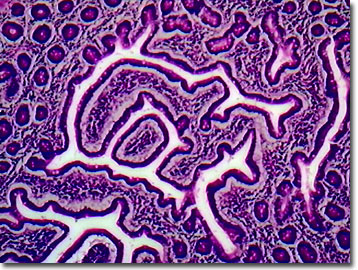Brightfield Digital Image Gallery
Human Auerbach's Plexus
"You are what you eat" may be true, but the mechanism by which ingested food becomes vital nutrition for the human body depends largely on the digestive system, including the small intestine. This critical organ, a convoluted tube, extends from the pyloric narrowing of the human stomach for about 20 feet in length as it tapers down to join the large intestine. The duodenum, the first of three parts, is the shortest (about 10 inches) and widest segment of the small intestine.

The small intestine receives masticated and partially digested food from the stomach and begins the process of absorption of nutrients via the villi. To help transport the digesting matter down the great length of the small intestine, well-developed muscles consisting of an inner circular and an outer longitudinal layer are utilized (peristalsis). Driving these muscles are sympathetic and parasympathetic nerve fibers of the autonomic nervous system. Two ganglionic sites form where the synapses of the parasympathetic fibers meet: the myenteric Auerbach's plexus and the submucosal Meissner's plexus.
The Auerbach's plexus lies between the longitudinal (outer muscle layer) and circular muscular (inner) coats of the duodenum. Peristaltic movements of digesting material originate in the muscles (myogenic) and are initiated by local reflexes. The peristaltic reflex can occur without any neural connections to the brain or spinal cord. Stimulation of the sympathetic nerves inhibits movements while parasympathetic stimulation accelerates peristalsis.
Hirschsprung's Disease is a genetic disorder that prevents the propulsion of digesting matter, leading to functional obstruction. The affected intestine segment shows an absence of ganglion cells and presence of enlarged nerve trunks in the Auerbach's and Meissner's plexuses. In the normal digestive tract, the Auerbach's plexus innervates the two smooth muscle layers and the mucous layer. Release of the neurotransmitter acetylcholine stimulates intestinal contractions, while antagonists such as atropine can block its action. Other drugs have been developed that block the action of the ganglia while those that stimulate the sympathetic nerves also inhibit peristalsis.
Contributing Authors
Cynthia D. Kelly, Thomas J. Fellers and Michael W. Davidson - National High Magnetic Field Laboratory, 1800 East Paul Dirac Dr., The Florida State University, Tallahassee, Florida, 32310.
BACK TO THE BRIGHTFIELD IMAGE GALLERY
BACK TO THE DIGITAL IMAGE GALLERIES
Questions or comments? Send us an email.
© 1995-2025 by Michael W. Davidson and The Florida State University. All Rights Reserved. No images, graphics, software, scripts, or applets may be reproduced or used in any manner without permission from the copyright holders. Use of this website means you agree to all of the Legal Terms and Conditions set forth by the owners.
This website is maintained by our
Graphics & Web Programming Team
in collaboration with Optical Microscopy at the
National High Magnetic Field Laboratory.
Last Modification Friday, Nov 13, 2015 at 01:19 PM
Access Count Since September 17, 2002: 14539
Visit the website of our partner in introductory microscopy education:
|
|
